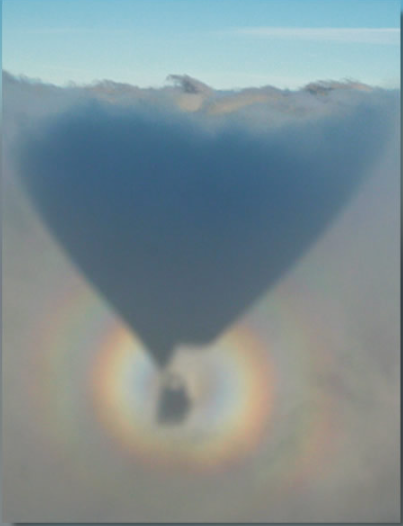Balloon Glory
Balloon Glory: Exploring the Spectacular Atmospheric Phenomenon
Have you ever witnessed a hot air balloon casting its shadow onto the clouds? It's a sight that evokes a sense of wonder and awe. But that's not all - if you look closely, you'll notice a stunning display of colors surrounding the balloon's shadow. This optical phenomenon is known as a "glory," and it never fails to captivate observers. In this article, we will delve into the intricacies of the balloon glory, shedding light on its formation and the fascinating science behind it.
The Enigmatic Balloon Shadow and Glory
As a hot air balloon floats gracefully through the sky, its shadow appears mysteriously on the clouds below. This looming silhouette adds an ethereal touch to the already breathtaking scene. But what makes it even more enchanting is the glory that encircles the shadow. At the center of this celestial halo lies a brilliant white ring, surrounded by concentric circles of vibrant colors. It's as if nature herself has painted a masterpiece in the sky.
Unraveling the Secrets of Glories
Glories are optical phenomena that arise from the scattering and diffraction of light by minuscule water droplets suspended in the atmosphere. While this explanation may sound simple at first, the reality is far more complex. The classical ray path through a water droplet is an impossibility, as the pieces simply do not fit together. Instead, surface waves come into play, with radiation traversing across part of the sphere's surface and a thin layer beneath it.
The Intricate Dance of Light and Water Droplets
The size of the water droplets plays a crucial role in the formation of a glory. Interestingly, the smaller the droplets, the larger and more pronounced the glory becomes. To grasp this concept better, you can conduct your own experiment using the Lorenz-Mie scattering simulator IRIS. By adjusting the droplet size, you can observe firsthand how it impacts the appearance of the glory.
A Practical Application for Balloonists
Beyond their aesthetic appeal, glories serve a practical purpose for balloonists. During a balloon meet, where multiple balloons take to the sky, it can be challenging to identify one's own balloon shadow amidst the cluster of shadows cast on the clouds. This is where the glory comes to the rescue. Balloonists can utilize the glory as a distinctive marker to determine which shadow belongs to their balloon, aiding them in estimating drift and rate of climb.
Further Explorations of Atmospheric Optics
The phenomenon of the balloon glory is just one captivating example of the wonders that atmospheric optics has to offer. The interplay between light and atmospheric particles gives rise to a multitude of mesmerizing optical phenomena. From rainbows and halos to iridescent clouds and sun pillars, the skies are a canvas for nature's extraordinary light shows.
Embracing Wonder and Curiosity
As we gaze up at the heavens, let us embrace wonder and curiosity. The study of atmospheric optics allows us to unravel the mysteries behind these awe-inspiring phenomena. By delving deeper into the science behind glories and other optical marvels, we can appreciate the intricate beauty of our natural world.
Conclusion
The balloon glory is a captivating atmospheric phenomenon that combines the surreal sight of a balloon shadow with a vibrant halo of colors. Formed through the scattering and diffraction of light by tiny water droplets, glories present a fascinating interplay between physics and nature. The size of the droplets influences the size and intensity of the glory, while balloonists can utilize this phenomenon to identify their own shadow amidst a cluster of balloon shadows. Let us continue to marvel at the wonders of atmospheric optics and explore the endless mysteries that unfold above us in the sky.

Balloon Shadow & Glory imaged by Nigel Puttick from a hot air balloon at an altitude of 2000m over Thirsk, North Yorkshire, England.. Image ©Nigel Puttick, shown with permission.
The balloon's shadow looms uncannily onto the clouds. Surrounding the camera's position in the basket is a glory, white at its centre with successive multi-coloured rings.
Glories always surround your shadow, or at least that of your camera. Balloonists at a meet wanting to estimate drift and rate of climb often use the glory to identify which balloon shadow is theirs.
Glories are formed by light backward scattered and diffracted by small water droplets. Read quickly that is almost believable. The reality is more complicated. The classical ray path (below) through a water drop is impossible, the pieces do not join up. Surface waves are involved where the radiation travels across part of the sphere surface and a thin layer beneath.
The smaller the droplets, the larger is the glory. Experiment yourself with changing droplet size with the Lorenz-Mie scattering simulator IRIS.

Note: this article has been automatically converted from the old site and may not appear as intended. You can find the original article here.
Reference Atmospheric Optics
If you use any of the definitions, information, or data presented on Atmospheric Optics, please copy the link or reference below to properly credit us as the reference source. Thank you!
-
<a href="https://atoptics.co.uk/blog/balloon-glory/">Balloon Glory</a>
-
"Balloon Glory". Atmospheric Optics. Accessed on November 26, 2024. https://atoptics.co.uk/blog/balloon-glory/.
-
"Balloon Glory". Atmospheric Optics, https://atoptics.co.uk/blog/balloon-glory/. Accessed 26 November, 2024
-
Balloon Glory. Atmospheric Optics. Retrieved from https://atoptics.co.uk/blog/balloon-glory/.